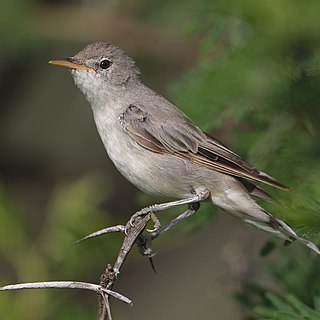
The olive-tree warbler is an Old World warbler in the tree warbler genus Hippolais. It breeds in southeast Europe and the Near East. It is migratory, wintering in eastern and southern Africa, from Kenya south to South Africa.

The Parmeliaceae is a large and diverse family of Lecanoromycetes. With over 2700 species in 71 genera, it is the largest family of lichen-forming fungi. The most speciose genera in the family are the well-known groups: Xanthoparmelia, Usnea, Parmotrema, and Hypotrachyna.

Pseudevernia is a genus of foliose lichens in the family Parmeliaceae. The type species of the genus, Pseudevernia furfuracea, has substantial commercial value in the perfume industry.
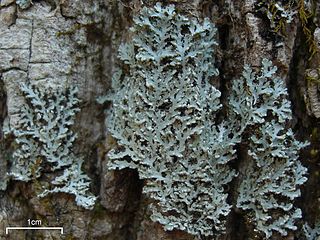
Heterodermia is a genus of lichenized fungi in the family Physciaceae. The genus has a widespread distribution, especially in tropical regions, and contains about 80 species.

Cetrelia is a genus of leafy lichens in the large family Parmeliaceae. They are commonly known as sea-storm lichens, alluding to the wavy appearance of their lobes. The name of the genus, circumscribed in 1968 by the husband and wife lichenologists William and Chicita Culberson, alludes to the former placement of these species in the genera Cetraria and Parmelia.

Punctelia is a genus of foliose lichens belonging to the large family Parmeliaceae. The genus, which contains about 50 species, was segregated from genus Parmelia in 1982. Characteristics that define Punctelia include the presence of hook-like to thread-like conidia, simple rhizines, and point-like pseudocyphellae. It is this last feature that is alluded to in the vernacular names speckled shield lichens or speckleback lichens.
Chicita Frances Culberson was an American lichenologist.
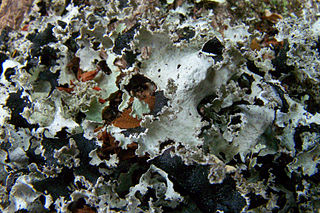
Platismatia is genus of medium to large foliose lichens in the family Parmeliaceae. The genus is widespread and contains 11 species. They resemble many other genera of foliose lichens in the Parmeliaceae, particularly Parmotrema, Cetrelia, and Asahinea. Most species are found in forests on the trunks and branches of conifer trees, although some species grow on rocks.

William Louis "Bill" Culberson was an American lichenologist.

Haematomma is a genus of crustose lichens established by Abramo Bartolommeo Massalongo in 1852. It is the sole genus in the Haematommataceae, a family circumscribed by Josef Hafellner in 1984. Commonly called bloodstain lichens, the species assigned to this genus are widely distributed in tropical and temperate areas.
A spot test in lichenology is a spot analysis used to help identify lichens. It is performed by placing a drop of a chemical reagent on different parts of the lichen and noting the colour change associated with application of the chemical. The tests are routinely encountered in dichotomous keys for lichen species, and they take advantage of the wide array of lichen products produced by lichens and their uniqueness among taxa. As such, spot tests reveal the presence or absence of chemicals in various parts of a lichen. They were first proposed as a method to help identify species by the Finnish lichenologist William Nylander in 1866.
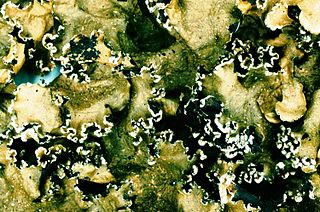
Cetrelia cetrarioides is a species of fungus belonging to the family Parmeliaceae.
Cetrelia sayanensis is a species of foliose lichen in the family Parmeliaceae. Found in Europe, it was formally described as a new species in 2009 by lichenologists Tatyana Otnyukova, Nikolay Stepanov, and John Alan Elix. The type was collected along the Kulumys ridge on the West Sayan Mountains of southern Siberia. Here it was found growing on the bark of an old stem of Sorbus sibirica, at an altitude of 800 m (2,600 ft). It has also been collected in several neighbouring areas, all at altitudes between 400–930 m (1,310–3,050 ft), with the bark of Abies, Betula, Salix, and Sorbus as the typical substrates. In 2019, the lichen was recorded from Austria, its first reported occurrence in middle Europe.

Cetrelia chicitae is a species of foliose lichen in the family Parmeliaceae. It is found in eastern Asia, North America, and Europe, where it grows on mossy rocks and tree trunks.
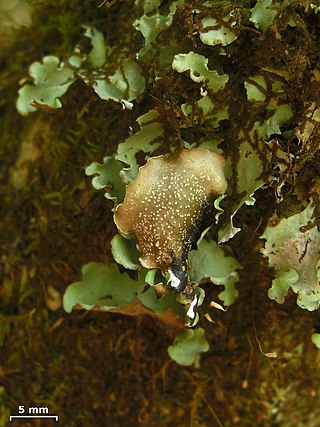
Cetrelia monachorum is a species of foliose lichen in the family Parmeliaceae. It was first described scientifically in 1930 by Alexander Zahlbruckner as a species of Parmelia. Husband and wife lichenologists William and Chicita Culberson transferred it into the genus Cetrelia in 1977. It is found in Asia, Europe, and North America.

Anziaic acid is a depside found in lichens. It gives a red reaction in the C test. The two phenolic rings have a pentyl side chain. It is an ester dimer of olivetolic acid.
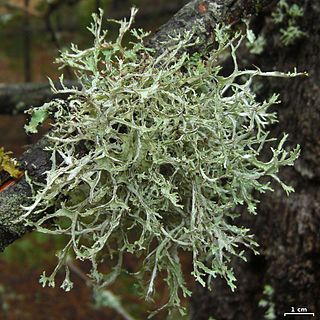
Platismatia stenophylla is a species of corticolous (bark-dwelling), foliose lichen in the family Parmeliaceae. It is found in western North America, from Vancouver Island south to central California, usually close to a shore. It was first formally described as a species of Cetrelia in 1882 by American lichenologist Edward Tuckerman. William and Chicita Culberson transferred it to the genus Platismatia in 1968. The lichen is distinguished from others in its genus by its narrow, linear lobes. It contains caperatic acid and atranorin as lichen products.
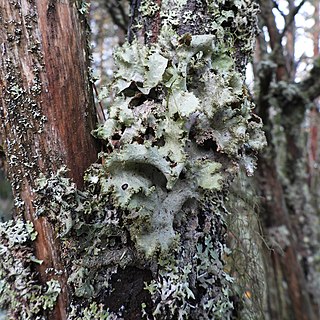
Platismatia glauca is a common and widespread species of corticolous (bark-dwelling), foliose lichen in the family Parmeliaceae.















